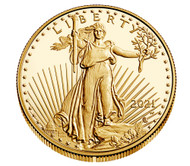What You Need to Know About Recent Gold Trends
Posted by Bullion Shark on Jun 25th 2021
2023 Gold Price Trends
Last week the spot price of gold declined 6%, which was its steepest drop since March 2020, when news of the extent of the COVID-19 pandemic caused global markets, including gold, to get hammered.
The main reason was comments from Federal Reserve Chairman Jerome Powell that indicated he was surprised by how large and persistent the increase in inflation has been recently and that the Fed would move up its target date to begin raising interest rates by a year to 2023.
Interest Rates and Other Key Factors
Interest rates are a key factor shaping gold prices because if rates -- in particular on long-term U.S. Treasury bonds -- are rising, investors may be more willing to put their money there than to pay the opportunity costs of owning gold that pays no interest and needs to be protected.
However, what many people overlook is it is the real interest rate after factoring inflation that matters. As one analyst puts it, “Gold will rise if you can make more money from ‘real money that can’t be printed’ than from over-printed money.”
There is currently a very substantial rise in inflation with the Consumer Price Index having risen in April by .8%, which is an annual rate of 9.6% -- the highest in almost two decades. Some people see it as being driven mainly be transitory factors such as supply chain disruptions caused by the pandemic, while others believe it is going to be a bigger and longer-lasting problem.
And may people believe the way the Fed measures inflation suppresses the actual rate of price increases in the economy, which these days everyone who is a consumer is experiencing.
In addition, the dollar is being devalued through the largest expansion of the U.S. monetary base in history, which is up 75% just since early 2020 and is now over $6 trillion. Compared to before the start of the 2008 financial crisis, it is up a whopping 620% and could exceed $10 billion if it continues on the present course due to bond buying by the Fed and economic stimulus programs.
But this week Powell walked back his comments, which had also sent stocks down sharply, saying that the Fed is nowhere near to raising rates and the renewed expectation of lower rates for a longer period sent gold back up. Powell also said inflation would not be the only factor in raising rates.
These latest remarks led stocks and gold to rebound this week.
Another factor supporting strong gold prices is that the dollar has been falling against other currencies and the U.S. Dollar Index (DXY) is down almost 12% since the pandemic lockdown began in March 2020.
In addition, as is the case with silver, demand for gold bullion has been very strong since the start of the pandemic. For example, U.S. Mint sales of American Gold Eagles in May 2021 were 20,500 ounces compared to 11,500 in May 2020 – an increase of 78.3%. And sales of American Gold Buffalo coins went from 2,500 last May to 44,000 this May – an increase of 1,660%!
And also as with silver, premiums on all gold coins remain steep as a result of delivery delays and allocations, high demand and production delays cause by COVID-19 protocols at mints.
IMF Proposal
French President Emmanuel Macron, whose country has many former colonies in Africa that are still linked in certain ways to France, earlier in June made a proposal to fund increased aid for the Africa, whose economies have been hurt by the pandemic, by having member of the Group of 7 contribute some of their gold reserves to the International Monetary Fund, which would be sold to help pay for the aid.
In 2009 and 2010 the IMF sold some its gold to central banks, including that of China and India that bought most of it.
Experts believe that of Macron’s proposal is implemented, it would likely have only a temporary effect on gold prices, i.e., causing a short-term decline that would not be a big issue given the historically high level of demand for gold today.
Overall, gold has definitely not done as well in 2021 as it did in 2020, In addition the fact that the spot price has been mostly trading in the $1800-range, which is $200 less than the high reached last year, gold-backed ETFs have seen a substantial pullback due to concerns about rising rates. But that has been offset by the strong demand for physical gold coins and bars and the fact that central banks continue to add to their gold reserves.
With the level of demand and continued shortages of gold bullion and the prospect of real interest rates after inflation likely remaining low in the future plus the ongoing devaluation of the dollar and loss of its purchasing power, the outlook for gold remains positive going forward.
Investors looking to add gold to their portfolios or to increase how much they have may consider both modern U.S. gold, including American Gold Eagles and American Gold Buffalo coins and especially pre-1933 gold, which is currently priced at much lower premiums than in the past.



